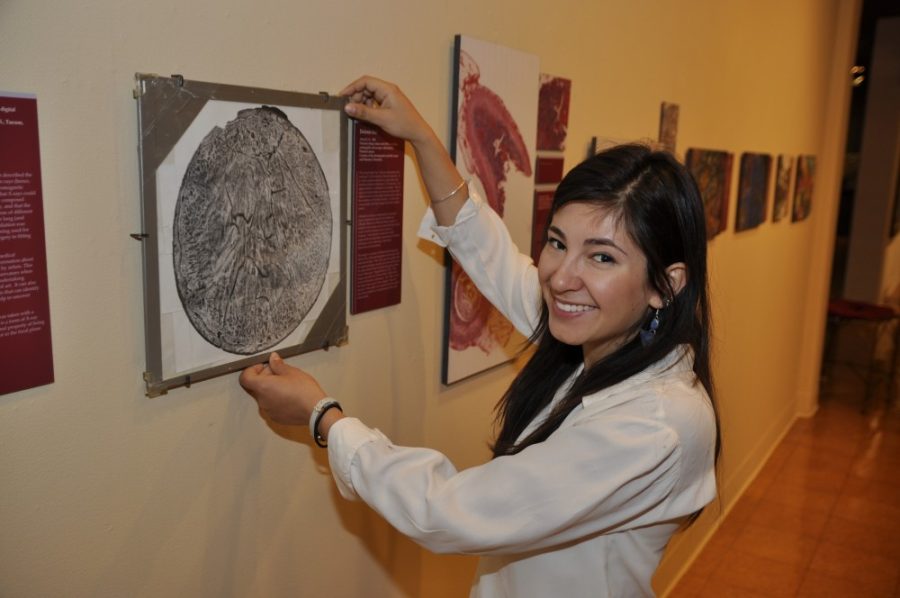Ersilia Anghel is bridging the gap between science and art.
Double majoring in chemistry and art history, Anghel spends most of her week doing surgery lab research. The rest of her time goes to learning about sculptures and the history of aesthetics, a branch of philosophy that deals with the creation and appreciation of beauty.
These two worlds are very different, but Anghel has found a way to integrate them both in a new art exhibit in the Museum of Art and Archive of Visual Arts. Anghel helped curate the exhibit, which is filled with a range of scientific photography.
“These people’s environments are very different and they become very different kinds of people, like science geeks or arts and humanity people,” Anghel said. “I think each group has a lot to learn from the other one and the point was to bring together these two worlds in a fun way.”
Anghel was born in Romania and moved to Canada when she was two. She moved to the United States when she was 15 and has been living here for six years. She received her U.S. citizenship in January.
With a triple citizenship and knowledge of three different languages, she has gained a world perspective that has heavily influenced her life. Travel to different countries and exposure to a variety of artwork helped her decide to minor in art, then later major in it.
Her decision to curate an exhibit was sparked by her desire to do something an art historian would do. She wrote up a proposal and received a $1,500 grant from the Honors College.
Anghel worked with Lauren Rabb, curator of the UA’s Museum of Art, throughout the summer, using the honors research grant to do background research and explore the meaning of scientific art.
Although Anghel initially wanted to incorporate international art, the cost was too high, resulting in a shift toward UA artwork. Anghel set up meetings with faculty, researchers and staff on campus and told them about the exhibit.
“I really had to improvise, which actually ended up being better because people from the U of A got to see what kind of art happens behind the scenes,” Anghel said. “It’s also exciting for people who don’t think they’re artists, like people who work with meteorites, minerals and plants and be like, ‘Wow, my stuff is in an art exhibit.’”
After finding her focus, Anghel had to research and contact people, as well as write descriptions for photos, print and make labels. She also worked with the staff that installed the exhibit.
Despite all the tasks she had to complete, Anghel was extremely happy she had the chance to combine both science and art.
“People say it’s important to do what makes you happy in life, and that’s really what I’ve tried to do while I have been at the U of A,” Anghel said. “The fact that I’ve been lucky enough to find something that incorporates two of my main interests makes it even more enjoyable.”
Since the exhibit began in January, people have asked her to consult on their images of scientific photography, or simply told her that she helped them understand the art and beauty in the natural world.
“I was already happy when the exhibit was up and I could walk around and show my friends. I thought that was going to be the best part,” Anghel said. “But having just complete strangers from the community email me about it was really nice. I feel like I made some kind of impact.”
The exhibit, which is free to students during regular hours, lasts until May 27 and allows viewers to appreciate patterns in the natural world and provides an opportunity for them to look at art and interpret it in their own way.
While putting together the exhibit, Anghel also had to balance doing biochem research in a surgery lab, volunteering at a hospice and attending her classes. On top of that, she also worked on making a book for her art history thesis about her photography.
“Ersilia is incredibly brilliant and really hard working. She juggles a lot of plates at the same time,” Rabb said. “She’s the type of student that if she says she’s going to do something, it’s probably going to turn out good.”
Now, after four years at the university, Anghel is preparing to graduate in May. Although she eventually wants to attend medical school, she plans on taking a year off to try and establish a program at the UA that would allow volunteers to work at orphanages and hospitals in Romania.
No matter what she chooses to do in the future, Anghel knows she will never give up her passion for art.
“I don’t give up things I really enjoy doing, because I feel like that is copping out on life,” Anghel said. “Basically, most of what I do is because I like to do it and because I care about it. It’s always been a part of my life, so I think it is always going to be … it’s part of who I am.”









